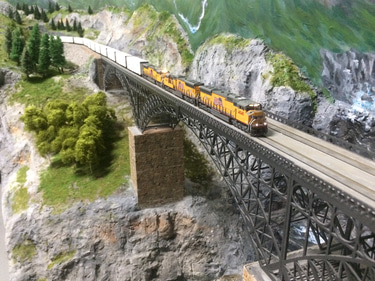About
Sydney N Scale Model Railway Club has been helping N scale modellers for over 50 years.
The club was formed to foster the interests of the hobby in general and in N scale modelling in particular. We are open to anyone interested in N scale modelling of any prototype and era.
The club has a large permanent layout, named the Cascade Union Railway, as well as a number of portable layouts that are used for exhibition purposes. All layouts operate using the Digitrax DCC system.
Our members find that being part of a club is a great way to learn new skills, to exchange ideas and news and, most importantly, to have fun. Another benefit of belonging to a club is that all members are always willing to pass on their skills to others. Occasionally we run clinics to pass on specific skills. Plus, as we are always building layouts, you can learn all the basic skills needed – building benchwork, laying track, wiring, and scenery
If you are interested in N scale, why not come and visit us at our clubrooms.
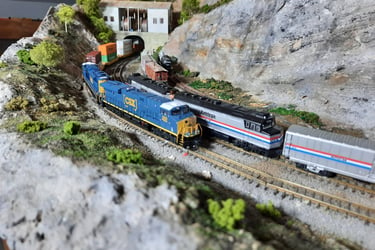

A Potted history of the club
The following is a brief history of the club, from its founding in 1971 through to the current day...
The 70’s
The first recorded meeting was 6 June, 1971 with 5 people in attendance. Over the next few months, the numbers grew.
After a couple of months, the group agreed on the name of the club – Sydney N Gauge Model Railway Club. Meetings were once per month at various members’ homes.
By May, 1972, the club had agreed on a standard for modules that each member could build, and bring to a meeting for operations. However, the club displayed a small layout, owned by one of the members, at the 1972 AMRA Sydney exhibition
The first AGM was held in July 1973, and it was then announced that the club had obtained access to what was to become the club’s first clubrooms, a hall in Sefton. It was also decided that from then on the club would meet twice a month.
The club also decided to display their modules at the 1973 AMRA Sydney exhibition. The display was something very different from other exhibits as the trains moved from one end of a single track line through the different modules to the other end with switching at each module along the way. The modules were not fully sceniced, and the main line between the modules were just bare boards with a piece of track on it. However, the display achieved its goal in that it attracted a number of new members.
Despite the success of the module display, the club built a new exhibition layout featuring a folded oval of double track with a station for switching at the front. This layout was almost constantly updated and upgraded over the next five years.
In May 1976, the club moved to a church hall in Waterloo for both running and working days – we had some on-site storage, so we were able to reduce the demand on individual members’ homes.
In June 1978 the club moved to a church hall in Drummoyne. It was a good move, as we had even more storage space and a bigger hall to run the modules, and in some days we had very little room left once all the modules were connected.
The modules made a re-appearance at the AMRA Sydney exhibition in 1979, along with the exhibition layout. As part of the module layout, the club had built a large fiddle yard, called SUSY, which provide plenty of storage for trains. SUSY became the name for any fiddle yard that the club built for its different layouts.
The 80’s
In January 1984, the club moved to Ramsgate, and the first permanent clubrooms, with an official opening of the clubrooms in February. Meetings were now every Saturday. Meeting were from 2pm to 10:30pm. Initially, running days were on the modular system, as well as the exhibition layout.
In November 1985, it was agreed that the club would build a permanent layout. The initial benchwork and track laying progressed reasonably quickly, to the point that it was possible to run trains over the first stage after just a year of work.
In February 1988, the club was formally incorporated. It was also at this time that the name of the club changed, to Sydney N Scale Model Railway Club, Inc.
The 90’s
In 1994 the club was advised that the hall was being required as part of the proposed M6 development, so another move was needed. This time, the club moved to Bankstown Airport, or on the boundary of the airport, where an unused building was obtained. The permanent layout was dismantled and moved to the new site. The new site was much larger than the Ramsgate hall, so expansions to the layout were made.
The 20’s
Despite the restrictions imposed by Covid 19, we have been very busy building the Cascade Union Railway, and now have two levels of the layout operational and fully scenicked. Work has commenced on the third level, with the first yard now built, and now being wired and fitted with point motors. At the same time, we have also built two new exhibition layouts, Tannochbrae and Gresham.
In 2024 we commenced the development of some new modular layouts, which can also be used for exhibitions. These modules will operate with a common fiddle yard at the rear and different layout segments (consisting of two or more modules with full scenery) at the front. The first layout segment has now been built and was initially displayed at the Dee Why Exhibition in July 2025. This module is called Dunkirk, NY. Two more layout segments have had their modules constructed, and are both now under development with plans to display these at different exhibitions in 2026.
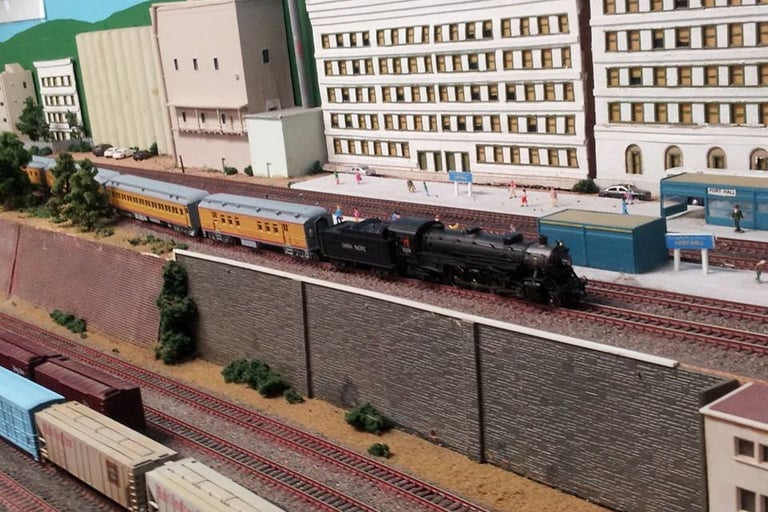

The 00’s
Another move was required in 2001 when the club moved to Guildford. An even bigger venue which, in turn, allowed for further expansion of the layout.
The fates, however, stepped in and the club had to move yet again in 2006, this time to clubrooms in Peakhurst. Unfortunately, the arrangement of the rooms at Peakhurst meant that the permanent layout could not be easily moved yet again, and a decision was made to start from scratch with a new layout. This was the Blackfoot and New Meadows. The layout was under construction for nearly all the time the club was at Peakhurst, and certainly changed from the original design.

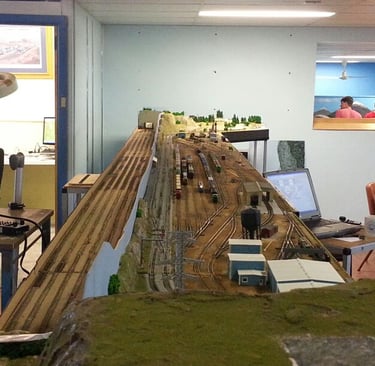
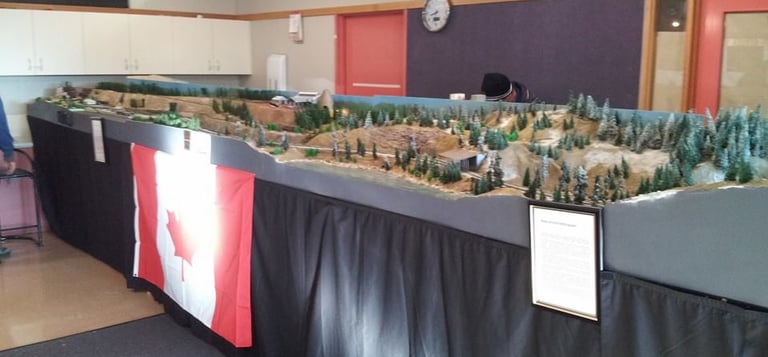

The 10’s
With ongoing development of the permanent layout, we also found time to construct some exhibition layouts.
The first was Wishram, and the second was Moose Jaw Southern. Both represented areas in North America, Wishram in northwest USA and Moose Jaw in western Canada. To provide an alternative, one of the members built a Victorian based layout, then offered it to the club for exhibition use. This layout is Widgeree.
Towards the end of 2018, due to the building at Peakhurst being declared unsafe, Sydney N needed to move again. This time it was to Rockdale, and the current clubrooms. Again, the decision was made to start afresh on the permanent layout.
Construction of the new layout, named the Cascade Union Railway, commenced soon after the overall plan had been approved by the members in July 2019.
